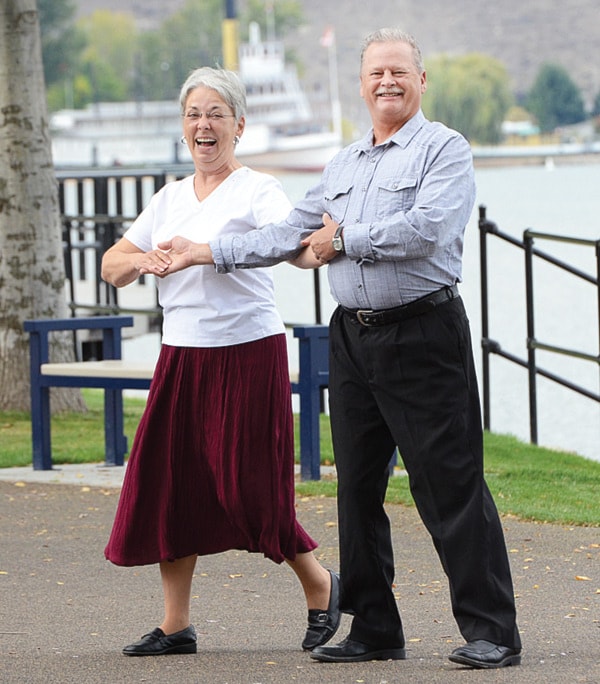Dianne Tucker
Special to the Western News
Square dancing has been part of Penticton culture for 61 years.
Some may remember the jamborees that drew thousands of people to dance for a whole week at King’s Park on an outdoor wooden floor. It was made of many connecting sheets of plywood that took volunteers two days to assemble and disassemble. Experienced dancers prefer a wooden floor because it has some give, making for less impact on the feet and legs.
A smaller version of the jamboree still takes place today during the annual Peach Festival. An active local square and round dance club, the Penticton Squares, continues to provide an outlet to enjoy the recreation throughout the year.
Square dancing is a social dance form with English, French, Scottish and Irish roots. The early Canadian settlers brought with them the folk dances of their homelands, like the schottische, quadrilles, jigs, reels and the minuet. As the communities grew and people of different backgrounds intermingled, so did their dances.
The dance repertoire expanded and it became increasingly difficult for the average person to remember the various movements. The person who had a knack for remembering the dance patterns and figures would cue or prompt the dancers in case they forgot what came next. This prompter became known as the caller.
Lacking the organized recreation of today, the hardworking pioneers needed an activity that would provide enjoyable exercise as well as social contact with neighbours. Square dancing fulfilled that need. The only requirements were a wooden floor, music and a caller. So, a barn, someone’s living room, the town hall, or the church provided the place. There was always someone on hand who could call and another who could play a guitar, fiddle, banjo or accordion.
Square dancing has evolved greatly over the years. The barn, the bale of hay, the fiddle and the little brown jug disappeared from the scene. Today’s dancers meet in air-conditioned halls with a hardwood floor and move to modern music. A pleasant mix of classic rock, top 40, country, Latin, and oldies is played at most square dances.
As a new dancer, I am very enthusiastic about today’s style of square dancing. Music like Moves Like Jagger, Haven’t Met You Yet and All Night Long put a little spring in your step. It’s so much fun.
The mechanics of the dance are simple, because there are no steps to learn, as such. You simply walk to the rhythm of the music. Most action is in the upper body, that’s great for men who say they have two left feet. Dancing for two hours is equivalent to walking six kilometres. I’m glad I put this fitness program on my bucket list.
From October to April, new square dancers learn 68 moves in the basic and mainstream programs which qualifies them to dance anywhere. That includes the Okanagan Valley, B.C., Canada or globally. Even Penticton’s sister city in Japan, because the dance moves are standardized and called in English worldwide.
Round dancing is a companion dance form at many square dance clubs. “Rounds” are choreographed dances for two persons. Moving as couples, they dance in a circle, hence the round dance name. The steps are similar to ballroom dancing, including waltz, two-step, cha cha, foxtrot, jive and other rhythms. A cuer, similar to a caller, prompts the dancers as they glide around the floor.
Singles in square and round dancing means: someone doesn’t have a regular weekly dance partner.
Couples means having a regular weekly dance partner. It could be a married couple, common-law, or a widow and widower who do not live together but are companions, friends, and dance partners, or a widow and a married friend whose wife does not dance, or a 12-year old brother with 10-year old sister, or an adult female with her teenage nephew, or two females.
We dance in a square of eight persons. Traditionally, the male is on the left, the female on the right. Today, it’s simply the left dancer and the right dancer. Because there’s a shortage of male dancers, these female dancers that know both left and right are quite in demand.
The terms singles and couples also apply to round dancing/choreographed couple dancing. The two-step and waltz lessons start Sunday, Oct. 5, 3-4:30 p.m. at the South Main Drop-In Centre. Contact Regine Anderson at 250-493-4248 or reanderson@shaw.ca for more information.
The new square dancer’s attire at regular weekly dances is dressy casual, the long skirt is very popular, and footwear that won’t mar the floor.
While the dancing has seen many changes over the years, one thing has remained constant: the fun, fitness and fellowship. During the B.C. Square and Round Dance Awareness Week, square dance clubs throughout the province invite singles, couples, families (children eight years and older) to join them.
Try Today’s Square Dancing for free on Oct. 2, at the Lawn Bowling Club, 260 Brunswick St., 7 to 9 pm. For details: 250-770-8152, or pentictonsquares@shaw.ca.
